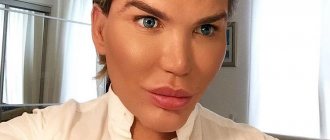Sharon Stone, in a recent interview with The New York Times, said that she was the victim of unsuccessful plastic surgery - the doctor changed the shape of the actress’s breasts without her consent.
We talk about plastic surgeries that have greatly ruined the appearance of different people.
Jacqueline Stallone
Jacqueline Stallone (98), mother of the famous actor Sylvester Stallone (73), admits that she has more than once regretted the decision to go to the surgeon. She has performed rhinoplasty, blepharoplasty, chemical peels and anti-aging facial contouring. Many people compare Jacqueline to a chipmunk with nuts stuffed into her cheeks. It's cruel! But what else can I say - plastic surgery only harmed her!
Renee Zellweger
Source: @renee__zellweger
In the fall of 2014, the actress, remembered by everyone for her role as Bridget Jones, shocked fans with a “new” face: she was literally not recognized. Discussions immediately began about what plastic surgery services Renee resorted to.
Today the passions have subsided, but the question remains open: what did the actress do to herself and why did the changes cause such a flurry of discontent?
The actress herself denies that she went under the surgeon's knife. Experts who studied her photo as an example of unsuccessful celebrity plastic surgery claim that the most Renee could do with herself was a Botox injection in the forehead area, procedures with anti-aging threads and a diet. Having lost weight, the star lost her “trademark” cheeks, which is why the shape of her eyes began to look different.
Christina Ray
Christina Ray (29) made her first lip filler injections at the age of 17. Then the girl considered herself terribly unattractive. Now, after hundreds of injections, she is completely satisfied with her appearance. By the way, Christina’s lips are registered in the Guinness Book of Records as the largest in the world. Ray is not going to stop there and intends to make them even more.
Donatella Versace
Donatella Versace (65) is the case when after one successful plastic surgery you can no longer stop. It all started with a small rhinoplasty and lip correction, and turned into numerous operations: correction of the oval of the face, blepharoplasty, smoothing of facial wrinkles, hundreds of injections for the “beauty” of lips, peelings and polishings. Donatella before and after are completely different people!
Amanda Lepore
Amanda Lepore (52) spent thousands of dollars on plastic surgery, which she began “practicing” at the age of 15. Then Amanda was... a guy and had her first rhinoplasty. From the age of 17, Lepore actively began to transform into a woman. Every year she changed something about herself - she enlarged her lips, buttocks, breasts and hips, corrected the shape of her forehead and cheeks. Now Amanda is a successful model and singer. But still, her appearance leaves much to be desired!
Face and neck lift
Complications and risks of facelift
Postoperative bleeding.
If such bleeding occurs, it is usually in the first 10-12 hours after the tightening, and is accompanied by increasing pain and swelling. When these symptoms appear, the bandage is removed and the surgical wound is inspected. For this reason, the patient after a facelift is advised not to leave the clinic immediately after the operation. If bleeding does occur, it is usually easy to stop; to do this, an incision is opened, the small amount of blood that has accumulated under the skin is removed, and the vessels that are bleeding are cauterized. Post-operative bleeding does not usually have a negative impact on the outcome of a facelift.
The risk of bleeding after a facelift is greater if the patient took or is taking acetylsalicylic acid (aspirin, etc.) or some other anti-inflammatory drugs before the operation. There is an increased risk of post-operative bleeding after a facelift and in patients with high blood pressure, which is why it is important to keep it under strict control before surgery with prescribed medications. For the same reason, it is advisable for the patient not to strain after a facelift: tension and anxiety can increase blood pressure and thereby increase the risk of bleeding. If a blood clot has formed somewhere under the skin that is too small to be noticed and removed, then after the swelling has subsided, a slight swelling may remain in that area. It will disappear over time, but this may take weeks or even months.
Skin necrosis in the suture area
Another risk of a facelift is that small patches of skin behind and around the ear may die. This is a fairly rare complication of a facelift, and most victims are smokers who did not stop smoking before surgery, at least 2 weeks before surgery. For patients with diabetes and atherosclerosis, the risk of facelift complications is also slightly higher than average. For healthy non-smoking patients with properly performed surgery, this risk is negligible. After a facelift, there may be a slight decrease in the sensitivity of certain areas of the face, which usually recovers from 6 months to 1 year.
Postoperative paresis of the branches of the facial nerve
There is also minimal risk of damage to the external branches of the facial nerve with a facelift. Two parts of this nerve are especially vulnerable: the lower branch, which lowers the corners of the mouth, and the upper one, which raises the eyebrows and wrinkles the forehead. Some weakness of these muscle groups after a facelift is possible and may be caused by swelling that compresses any branch of the nerve. In such a case, complete restoration of facial expressions may take from several weeks to several months. But damage to these nerves during a facelift is extremely rare.
Formation of rough postoperative scars
For most patients, facelift scars are almost invisible because they are located in natural creases or hair. However, if there are problems with healing (in smokers, for example), the scars may be more noticeable and will subsequently require correction. The risk of infection during a facelift is also negligible - this is primarily due to its good blood supply.
Patients' prejudices regarding facelift
- The first of these concerns the age at which surgery should be performed. When it comes to indications for facial tissue lifting, it is not the specific age that is important, but the presence of objective indications and the patient’s desire. So it could be 35, 50 or 70 years. Without a doubt, the most harmonious result is obtained with the initial signs of aging.
- The second prejudice is that “surgeries on the eyelids, face, neck, and chin are best done in parts.” Splitting the necessary intervention into parts generally significantly extends the period of treatment and rehabilitation. It seems to me that in our dynamic world a person cannot spend so much of his life waiting, moreover, associated with moral and physical suffering. In addition, a partial lift never gives the same aesthetic and long-term effect as a full face and neck lift.
- The third prejudice is that “after a tightening, the processes of aging and fading of the skin are significantly accelerated.” This prejudice is based on cases where the operation is performed during the critical premenopausal period for a woman. The aging processes of facial tissue that occur during this process can worsen the result of surgical intervention. In fact, after a well-performed operation, women always look younger than their peers.
- Before surgery, many women idealize the expected result - “I will look like I did at 25, and all the wrinkles will be completely straightened out . However, even a well-performed operation does not allow achieving such a result. The operation will allow you to look much younger and fresher, but you need to be realistic about its capabilities.
Jocelyn Wildenstein
Jocelyn Wildenstein (79) is known by many as Catwoman. In her youth, Jocelyn wanted to keep her billionaire husband by any means possible. But many anti-aging procedures and hours spent in beauty salons did not give the desired result. Then she decided to turn to surgeons. Jocelyn performed a brow lift, blepharoplasty, canthopexy, inserted implants into different parts of the face, administered several dozen injections with Botox, hyaluronic acid and collagen, tightened the middle part of the face... it’s too much to list. Alas, she got the opposite effect - her husband got scared and filed for divorce.
Non-star story
My friend rashly complained about stretch marks after giving birth. When asked what she plans to do about it, the answer was: “Nothing. I’m not a model, why do I need an absolutely perfect body? I love myself, carrying this baby, and my husband loves me like this.”
There are no ideal people; they often love these same imperfections in their loved ones as a unique feature. As you can see, even the excellent work of a surgeon will not bring you happiness if you yourself do not want to become happy and love the real you. And this problem cannot be treated with a scalpel. So go to the mirror right now, look into your eyes and feel how much you love yourself!
Hang Mioku
For the first time, Korean woman Hang Mioku (52) turned to the help of a plastic surgeon at the age of 28 to eliminate her first wrinkles. Over time, the girl became dependent on fillers. When the number of injections exceeded all limits, the surgeons refused to work with her. After this, Hang independently injected vegetable oils under the skin. She hardly expected such a terrible result...
Dennis Avner
One can definitely say about Dennis Avner - he’s not like everyone else! This is what the man wanted when he decided to paint his body brindle. Further - more, to completely resemble a predatory cat, he had rhinoplasty - surgeons completely changed the tip of his nose and widened the back of it, and artificially narrowed his eyes. In addition, Dennis sharpened his ears, made a correction to his forehead and plastic cheekbones, changed his chin, ground down his teeth (after all, a real tiger should have fangs!) and even split his lips. The radical transformation led to complete loneliness, and in 2012 Dennis decided to die.
Read also
He is talented in everything: Emma Watson told when she fell in love with Tom Felton
Test: How much of a witch are you?
Kate Middleton celebrated her 40th birthday in a modest family atmosphere
How to prevent failed rhinoplasty
One of the main factors determining the effect of rhinoplasty is the experience and skill of the surgeon. A qualified doctor not only eliminates aesthetic defects and restores organ functions, but can also calculate all the risks and complications in each specific case.
When choosing a surgeon, it is important to consider not only general practice, but also the number of rhinoplasties performed. Study reviews and results of other patients
You should not trust a doctor who unconditionally agrees with the patient at the stage of discussing wishes. An experienced surgeon will offer minimal aesthetic correction that does not require disruption of the functional structure. To implement the patient’s wishes, the doctor can use a computer program to make an oriented form and display the image on the monitor.
Computer modeling will help to get a clear picture of the patient's wishes. In turn, the surgeon points out the consequences that may arise due to a significant change in the shape and size of the nose. Psychological complexes and the patient’s desire for radical changes can lead to unsatisfactory results of the operation.
Correct patient behavior is one of the main conditions for the success of the operation. Breaking the rules can ruin the work of the best surgeon. A number of mandatory recommendations are prescribed for the patient at the stage of preparation and recovery:
- give up smoking and alcohol a few weeks in advance. Bad habits negatively affect tissue healing processes;
- drug therapy is completed a month before rhinoplasty. You should not take drugs that affect blood clotting to avoid the risk of bleeding;
- during the recovery period, you need to refrain from any physical activity, sports, visiting the sauna, solarium, and follow a gentle regimen so as not to provoke surges in blood pressure;
- You need to sleep on your back on a high pillow to avoid injuries, deformation of the nose, and also speed up the subsidence of swelling;
- for about 2 weeks it is necessary to wear a plaster cast, which acts as a frame during the healing stage;
- For a month it is forbidden to eat too hot, cold foods, drinks, as well as those that cause chewing difficulties;
- It is not recommended to blow your nose for about 2 months; for hygienic procedures of the nose, the doctor prescribes special sprays, and peach or vaseline oil is also used for cleansing;
- It is not recommended to wear glasses until complete healing; they can lead to deformation of unhealed tissues;
- You cannot plan a pregnancy within a year after surgery.
When agreeing to rhinoplasty, it is important to choose a qualified surgeon, a proven clinic with an impeccable reputation. The responsibility of the patient is also important, providing truthful information about the state of health, taking tests, following medical recommendations
But even if all conditions are met, there are risks of developing unpredictable consequences.









